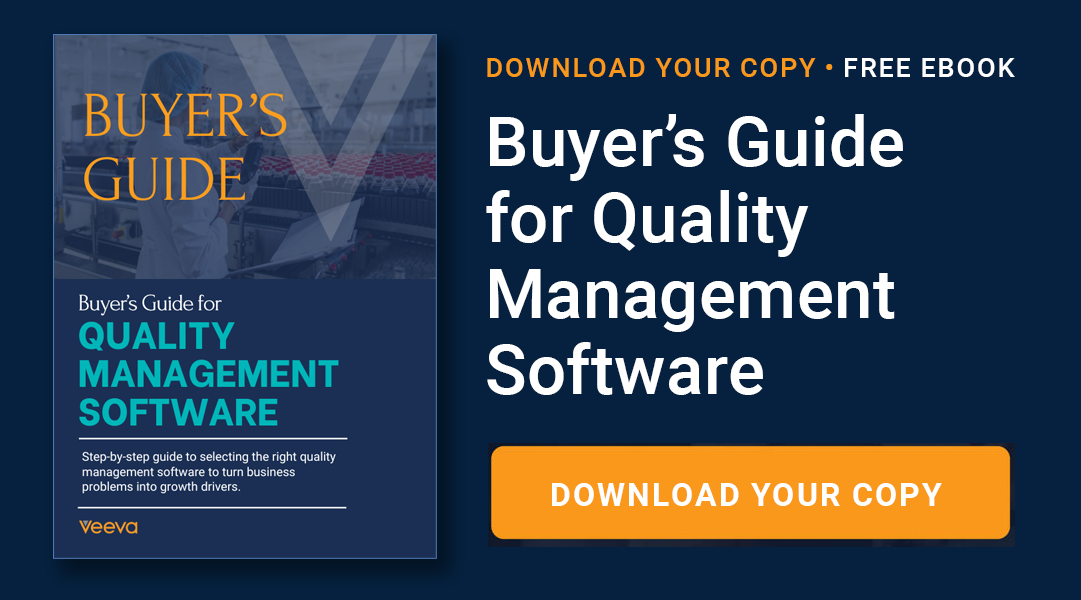Visit our Quality Solution Page to learn more about QualityOne.
Quality is a non-negotiable in your business success. A product or service that delivers on quality is one that pleases your preferred customers, causing them to return for more and spread the word to others that your business is worth patronizing. No quality...no customers...no business.
That much is obvious. The standards of quality you need to meet and the process of ensuring you meet them are less so. That’s particularly true in today’s rapidly evolving business climate where regulations, the application of technology, product standards, and customer tastes are moving targets.
Change is not likely to slow down in the future, though, so the best way to cope is by basing your quality management program on a strong quality plan. Quality planning is one of the critical components of an effective Quality Management System, no matter your organization’s size or industry.
What is a Quality Management Plan?
Quality planning is the first of four components of Quality Management, which also encompasses quality assurance, quality control, and quality improvement.
Quality Planning Process Summary
Quality planning is the process of making all the decisions necessary to ensure the quality of your product or service when it reaches your customers.
A quality plan is a document or set of documents that, together, define a company’s quality goals, standards, practices, resources, specifications, and procedures. It connects the overall strategic plans of an organization with actionable steps for designing quality into its deliverables and confirming that customers receive the quality experience that is intended.
Quality planning occurs at the very beginning of the total quality management process, but it should not be thought of as a “one-and-done” activity. An effective quality plan should be regularly reviewed and enhanced over time to keep pace with industry and regulatory changes as well as to improve your organization’s competitive position.
Related Post: Quality Acronym Reference Guide
The Quality Planning Process
Every organization will need to approach quality planning from the unique perspective of its own goals and capabilities. Some plans may be more detailed than others, and some areas within a company’s plan will be more exhaustive than others. However, there are general steps that lead to an effective plan. Every company needs to:
- Define the experience you want to provide to customers. Think about your customer’s needs, requirements, and preferences. Analyze the potential risks to their satisfaction. What should go right? What could go wrong? Be detailed. Incorporate information about industry regulations in this step too.
- Consider how best to deliver this perfect experience. This is about design. What kind of product will fulfill your customers’ wants and needs? Or what do your employees need to do to deliver an “exceeds-expectations” service experience?
- Define procedures for confirming your quality goals are met. Inspections? Testing? Customer feedback?
- Designate resources. Who carries out quality procedures? Who is ultimately responsible for their success? How will you tie quality goals to compensation and rewards? Also, consider training and funding in the resource section.
- Provide a blueprint for continuous improvement. How often will the quality plan be reviewed? By whom? How can incremental changes be incorporated between scheduled reviews?
- Have the plan reviewed by stakeholders. Be sure to gain the input of the people involved in implementing the plan, both at the beginning and during periodic reviews, to ensure it is realistic, actionable, and comprehensive.
Many companies have both strategic-level quality plans and project-level quality plans for specific orders. The resulting documents may be quite different, but the process is basically the same.
Quality Plan Elements
The concept is to plan in advance, as much as possible, what you want and expect from your people and products, how everyone will work together to make that happen, and what will be done to correct any mistakes that do happen. The elements in your organization’s quality plan(s) will depend on your industry and your specific needs and goals. However, here are some examples of items you could include:
- An overview of the products, services, or project with detailed quality criteria
- Details and analysis of applicable regulations
- Organizational chart with internal and external team members, their tasks and responsibilities
- Training processes
- External supplier standards, if applicable
- Performance standards — specifications, use, aesthetics, life cycle, etc..
- Performance documentation
- Inspection/testing procedures and timing
- Acceptance criteria
- Customer feedback procedures
- Corrective actions
- Reporting guidelines for specific problems and overall quality performance analysis
- Document modification procedures
Related Post: 4 Must-Have Components for Effective QMS Software
The Overall Benefits of Quality Planning
Think of quality planning as a way of managing the risk of unpleasant surprises. A good quality plan can:
- Help ensure conformance to internal and external standards and regulations
- Increase the level of customer satisfaction
- Minimize problems and complaints
- Make it easier to trace the source of any quality issues
- Provide objective data for evaluation and improvement of quality processes
- Make it easier to detect when improvements are needed, and how and where
Make Your Planning Count—Use the Right Technology to Implement Efficiently
Once you’ve developed a quality plan, you need to execute it effectively. If you’re ready to ensure compliance and agility in your quality management program, a unified cloud-based application like Veeva’s QualityOne can help you make that happen — faster and at less total cost..
QualityOne is intuitive and easy to use, unlike cumbersome on-premise legacy programs, so your staff will be able to easily and effectively use it to manage document control, training, quality processes, and HSE events.
- Reduce the cost of quality management
- Quickly and easily find and fix quality issues
- Access your files & dashboards from any device
- Visualize all product or quality data in one system
- Ensure your suppliers meet your quality standards
- Be audit-ready, anytime an auditor calls
Ready to revolutionize your quality management approach? Learn how QualityOne, Veeva's all-in-one quality management, training, and HSE solution, can help by visiting our product page.
SHARE






